-
 This game was an “add-a-ball” game; the replay version was called 2001. Production run was 490 units. This was the first game to feature the in-line drop targets in a bank of targets. It was designed by Ed Krynski with art by Gordon Morison. A total of 20 drop targets divided into 5 targets per color. Knocking down a full left set of targets or a right set of targets awarded extra balls to be played during your current game (versus free games as the replay version awarded). The targets would reset after each ball. Extra balls were also awarded if certain scores were achieved as set by the operator. Previous high scores could be posted by the arcade on the backglass as a contest to try and beat the high score. This game was near the end of single-player Gottieb games with the smaller flippers. All in all, a classic game requiring accuracy in your shots to gain extra balls!
This game was an “add-a-ball” game; the replay version was called 2001. Production run was 490 units. This was the first game to feature the in-line drop targets in a bank of targets. It was designed by Ed Krynski with art by Gordon Morison. A total of 20 drop targets divided into 5 targets per color. Knocking down a full left set of targets or a right set of targets awarded extra balls to be played during your current game (versus free games as the replay version awarded). The targets would reset after each ball. Extra balls were also awarded if certain scores were achieved as set by the operator. Previous high scores could be posted by the arcade on the backglass as a contest to try and beat the high score. This game was near the end of single-player Gottieb games with the smaller flippers. All in all, a classic game requiring accuracy in your shots to gain extra balls! -
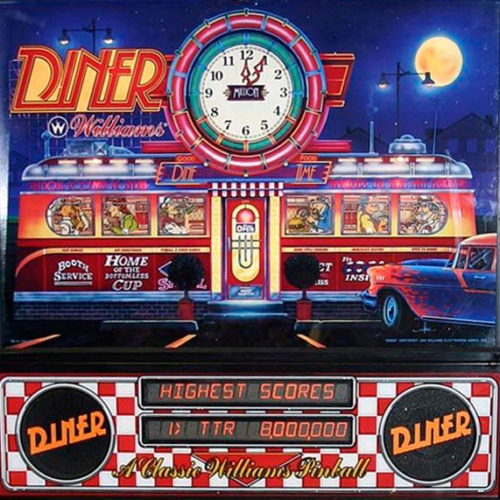
-
 There are 7 Doctors, as one can plainly see from the backglass… quite conveniently, they are numbered 1-7. Each Doctor has the effect of changing the rules of one area of the Playfield, making a list of the rules all the more annoying and probably confusing. First some general information about the Doctors… there are many ways to “spot” doctors throughout the game – one is awarded at the start of any ball, and can be spotted through the Transmat target or Video Mode. At the start of a ball (or when a ball has been locked), you get to choose the “current” doctor – his picture will flash on the backglass. When a doctor- spotting shot is made, the current doctor will become solidly lit (so his attributes are carried over for the rest of the game), and the “current” doctor becomes the previously unlit doctor directly to the left of the previous one. There are 2 ways to spot all seven doctors – either go through them all one-by-one, or shoot the Emperor Daleks jackpot. Either way, all of them will be lit for the rest of the game, and you receive an additional bonus of 2OM, as well as a small animation, which plays even after a tilt! After all 7 doctors are spotted, they can be spotted a second (third, etc) time, and running through all 7 a second time awards another 2OM bonus. Also, each doctor spotted in the game (this count may be more than 7) is worth a 1M bonus at the end of the last ball (so don’t tilt it!), and this bonus (unlike the regular bonus) is multiplied by the Playfield X.
There are 7 Doctors, as one can plainly see from the backglass… quite conveniently, they are numbered 1-7. Each Doctor has the effect of changing the rules of one area of the Playfield, making a list of the rules all the more annoying and probably confusing. First some general information about the Doctors… there are many ways to “spot” doctors throughout the game – one is awarded at the start of any ball, and can be spotted through the Transmat target or Video Mode. At the start of a ball (or when a ball has been locked), you get to choose the “current” doctor – his picture will flash on the backglass. When a doctor- spotting shot is made, the current doctor will become solidly lit (so his attributes are carried over for the rest of the game), and the “current” doctor becomes the previously unlit doctor directly to the left of the previous one. There are 2 ways to spot all seven doctors – either go through them all one-by-one, or shoot the Emperor Daleks jackpot. Either way, all of them will be lit for the rest of the game, and you receive an additional bonus of 2OM, as well as a small animation, which plays even after a tilt! After all 7 doctors are spotted, they can be spotted a second (third, etc) time, and running through all 7 a second time awards another 2OM bonus. Also, each doctor spotted in the game (this count may be more than 7) is worth a 1M bonus at the end of the last ball (so don’t tilt it!), and this bonus (unlike the regular bonus) is multiplied by the Playfield X. -
 Donkey Kong is an arcade game released by Nintendo in 1981. It is an early example of the platform game genre, as the gameplay focuses on maneuvering the main character across a series of platforms while dodging and jumping over obstacles. In the game, Jumpman (since renamed Mario) must rescue a damsel in distress, Lady (now named Pauline), from a giant ape named Donkey Kong. The hero and ape later became two of Nintendo’s most popular characters. Donkey Kong is one of the earliest examples of the platform game genre; it is sometimes said to be the first platform game, although it was preceded by Space Panic. In contrast to Space Panic, however, Donkey Kong was the first platform game to feature jumping, introducing the need to jump between gaps and over obstacles or approaching enemies, setting the template for the platform genre. Competitive video gamers and referees stress the game’s high level of difficulty compared to other classic arcade games. Winning the game requires patience and the ability to accurately time Jumpman’s ascent. In addition to presenting the goal of saving the Lady, the game also gives the player a score. Points are awarded for finishing screens; leaping over obstacles; destroying objects with a hammer power-up; collecting items such as hats, parasols, and purses (apparently belonging to the Lady/Pauline); and completing other tasks. The player typically receives three lives with a bonus awarded for the first 7,000 points, although this can be modified via the game’s built in DIP switches. The game is divided into four different one-screen stages. Each represents 25 meters of the structure Donkey Kong has climbed, one stage being 25 meters higher than the previous. The final screen occurs at 100 m. Later ports of the game omit or change the sequence of the screens. The original arcade version includes: Screen 1 (25 m), Jumpman must scale a seven-story construction site made of crooked girders and ladders while jumping over or hammering barrels and oil barrels tossed by Donkey Kong. The hero must also avoid fireballs which generate when barrels run into the oil drum at the bottom of the site. Players routinely call this screen “Barrels”. Screen 2 (50 m), Jumpman must climb a five-story structure of conveyor belts, each of which transports cement pans. The fireballs also make another appearance. This screen is sometimes referred to as the “Factory” or “Pie Factory” due to the resemblance of the cement pans to pies. Screen 3 (75 m), Jumpman rides up and down elevators while avoiding fireballs and bouncing objects, presumably spring weights. The bouncing weights (the hero’s greatest danger in this screen) emerge on the top level and drop near the rightmost elevator. The screen’s common name is “Elevators”. This screen appears as an unlockable stage in Super Smash Bros. Brawl. Screen 4 (100 m), Jumpman must remove the eight rivets which support Donkey Kong. The fireballs remain the primary obstacle. Removing the final rivet causes Donkey Kong to fall and the hero to be reunited with Lady/Pauline. This is the final screen of each level. Players refer to this screen as “Rivets”. The player loses a life if: Jumpman collides with a barrel, fireball, flaming oil barrel, spring weight, cement pan, or Donkey Kong himself Jumpman falls off the structure or through open rivet holes The bonus timer reaches 0. These screens combine to form levels, which become progressively tougher. For example, Donkey Kong begins to hurl barrels faster and sometimes diagonally, and fireballs get speedier. The victory music alternates between levels 1 and 2. The 22nd level is unofficially known as the kill screen, due to an error in the game’s programming that kills Mario after a few seconds, effectively ending the game. With its four unique levels, Donkey Kong was the most complex arcade game at the time of its release, and only the second game to feature multiple levels (the first was Gorf by Midway Games).
Donkey Kong is an arcade game released by Nintendo in 1981. It is an early example of the platform game genre, as the gameplay focuses on maneuvering the main character across a series of platforms while dodging and jumping over obstacles. In the game, Jumpman (since renamed Mario) must rescue a damsel in distress, Lady (now named Pauline), from a giant ape named Donkey Kong. The hero and ape later became two of Nintendo’s most popular characters. Donkey Kong is one of the earliest examples of the platform game genre; it is sometimes said to be the first platform game, although it was preceded by Space Panic. In contrast to Space Panic, however, Donkey Kong was the first platform game to feature jumping, introducing the need to jump between gaps and over obstacles or approaching enemies, setting the template for the platform genre. Competitive video gamers and referees stress the game’s high level of difficulty compared to other classic arcade games. Winning the game requires patience and the ability to accurately time Jumpman’s ascent. In addition to presenting the goal of saving the Lady, the game also gives the player a score. Points are awarded for finishing screens; leaping over obstacles; destroying objects with a hammer power-up; collecting items such as hats, parasols, and purses (apparently belonging to the Lady/Pauline); and completing other tasks. The player typically receives three lives with a bonus awarded for the first 7,000 points, although this can be modified via the game’s built in DIP switches. The game is divided into four different one-screen stages. Each represents 25 meters of the structure Donkey Kong has climbed, one stage being 25 meters higher than the previous. The final screen occurs at 100 m. Later ports of the game omit or change the sequence of the screens. The original arcade version includes: Screen 1 (25 m), Jumpman must scale a seven-story construction site made of crooked girders and ladders while jumping over or hammering barrels and oil barrels tossed by Donkey Kong. The hero must also avoid fireballs which generate when barrels run into the oil drum at the bottom of the site. Players routinely call this screen “Barrels”. Screen 2 (50 m), Jumpman must climb a five-story structure of conveyor belts, each of which transports cement pans. The fireballs also make another appearance. This screen is sometimes referred to as the “Factory” or “Pie Factory” due to the resemblance of the cement pans to pies. Screen 3 (75 m), Jumpman rides up and down elevators while avoiding fireballs and bouncing objects, presumably spring weights. The bouncing weights (the hero’s greatest danger in this screen) emerge on the top level and drop near the rightmost elevator. The screen’s common name is “Elevators”. This screen appears as an unlockable stage in Super Smash Bros. Brawl. Screen 4 (100 m), Jumpman must remove the eight rivets which support Donkey Kong. The fireballs remain the primary obstacle. Removing the final rivet causes Donkey Kong to fall and the hero to be reunited with Lady/Pauline. This is the final screen of each level. Players refer to this screen as “Rivets”. The player loses a life if: Jumpman collides with a barrel, fireball, flaming oil barrel, spring weight, cement pan, or Donkey Kong himself Jumpman falls off the structure or through open rivet holes The bonus timer reaches 0. These screens combine to form levels, which become progressively tougher. For example, Donkey Kong begins to hurl barrels faster and sometimes diagonally, and fireballs get speedier. The victory music alternates between levels 1 and 2. The 22nd level is unofficially known as the kill screen, due to an error in the game’s programming that kills Mario after a few seconds, effectively ending the game. With its four unique levels, Donkey Kong was the most complex arcade game at the time of its release, and only the second game to feature multiple levels (the first was Gorf by Midway Games). -
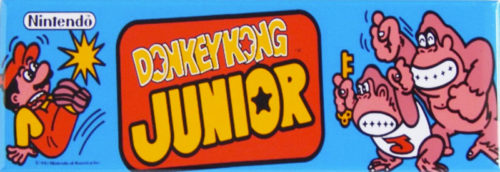 Donkey Kong Jr. is a 1982 arcade-style platform video game by Nintendo. It first appeared in arcades, and, over the course of the 1980s, was later released for a variety of platforms, most notably the Nintendo Entertainment System. The game’s title is written out as Donkey Kong Junior in the North American arcade version and various ports to non-Nintendo systems. Its eponymous star, Donkey Kong Jr., also called simply Junior[3] or abbreviated as DK Jr.,[4] is trying to rescue his father Donkey Kong, who has been imprisoned. Donkey Kong’s cage is guarded by Mario, in his only appearance as an antagonist in a video game. This game is the sequel to the video game Donkey Kong, which featured Mario as the hero and Junior’s father as the villain. Plot: Mario (known as Jumpman in Donkey Kong) has captured Donkey Kong and placed him in a cage as punishment for kidnapping his girlfriend Pauline.[5] Donkey Kong Jr. must rescue his father from Mario by working his way through a series of stages. Mario attempts to stop DK Jr. by releasing animals and putting obstacles in his way. When DK Jr. succeeds at the final level, Donkey Kong is freed and kicks Mario into the distance, leaving him to an unknown fate. Gameplay Like its predecessor, Donkey Kong, Jr. is an arcade-style platform game. There are a total of four stages, each with a unique theme. DK Jr. can run left and right, jump, and grab vines/chains/ropes to climb higher on the screen. He can slide down faster by holding only one vine, or climb faster by holding two. Enemies include “Snapjaws,” which resemble bear traps with eyes, bird-like creatures called “Nitpickers”, and “Sparks” that roam across the wiring in one of Mario’s hideouts. To pass the first three stages, DK Jr. must reach the key at the top. In the fourth stage, DK Jr. must push six keys into locks near the top of the stage to free Donkey Kong. After a brief cutscene, the player is taken back to the first stage at an increased difficulty. DK Jr. loses a life when he touches any enemy or projectile, falls too great a distance, or falls off the bottom of the screen. Additionally, he loses a life if the timer counts down to zero. The game ends when the player loses all of his or her lives.
Donkey Kong Jr. is a 1982 arcade-style platform video game by Nintendo. It first appeared in arcades, and, over the course of the 1980s, was later released for a variety of platforms, most notably the Nintendo Entertainment System. The game’s title is written out as Donkey Kong Junior in the North American arcade version and various ports to non-Nintendo systems. Its eponymous star, Donkey Kong Jr., also called simply Junior[3] or abbreviated as DK Jr.,[4] is trying to rescue his father Donkey Kong, who has been imprisoned. Donkey Kong’s cage is guarded by Mario, in his only appearance as an antagonist in a video game. This game is the sequel to the video game Donkey Kong, which featured Mario as the hero and Junior’s father as the villain. Plot: Mario (known as Jumpman in Donkey Kong) has captured Donkey Kong and placed him in a cage as punishment for kidnapping his girlfriend Pauline.[5] Donkey Kong Jr. must rescue his father from Mario by working his way through a series of stages. Mario attempts to stop DK Jr. by releasing animals and putting obstacles in his way. When DK Jr. succeeds at the final level, Donkey Kong is freed and kicks Mario into the distance, leaving him to an unknown fate. Gameplay Like its predecessor, Donkey Kong, Jr. is an arcade-style platform game. There are a total of four stages, each with a unique theme. DK Jr. can run left and right, jump, and grab vines/chains/ropes to climb higher on the screen. He can slide down faster by holding only one vine, or climb faster by holding two. Enemies include “Snapjaws,” which resemble bear traps with eyes, bird-like creatures called “Nitpickers”, and “Sparks” that roam across the wiring in one of Mario’s hideouts. To pass the first three stages, DK Jr. must reach the key at the top. In the fourth stage, DK Jr. must push six keys into locks near the top of the stage to free Donkey Kong. After a brief cutscene, the player is taken back to the first stage at an increased difficulty. DK Jr. loses a life when he touches any enemy or projectile, falls too great a distance, or falls off the bottom of the screen. Additionally, he loses a life if the timer counts down to zero. The game ends when the player loses all of his or her lives. -
 This Norm Clark and Christian Marsche creation was also produced in an add-a-ball version called Love Bug as well as a four-player version called Dipsy Doodle. This symmetrical playfield design has a captive ball under the playfield which, when activated, rolls over a switch to score a bonus batch of points based on the value of the button when the feature is lit. The top kickout hole randomly selects bonus features to make the game more intriguing. A popup post between the flippers prevents ball drain down the middle of the playfield, but this post may be retracted just at the wrong time if the down-post targets are hit. An extra ball may be achieved if the center target is lit. This target also activates the “doodlebug” under the playfield. Finally, a free ball gate is incorporated into the machine if the appropriate combination of pop bumpers and rollovers are made. A fast-paced game that was popular in its day.
This Norm Clark and Christian Marsche creation was also produced in an add-a-ball version called Love Bug as well as a four-player version called Dipsy Doodle. This symmetrical playfield design has a captive ball under the playfield which, when activated, rolls over a switch to score a bonus batch of points based on the value of the button when the feature is lit. The top kickout hole randomly selects bonus features to make the game more intriguing. A popup post between the flippers prevents ball drain down the middle of the playfield, but this post may be retracted just at the wrong time if the down-post targets are hit. An extra ball may be achieved if the center target is lit. This target also activates the “doodlebug” under the playfield. Finally, a free ball gate is incorporated into the machine if the appropriate combination of pop bumpers and rollovers are made. A fast-paced game that was popular in its day. -
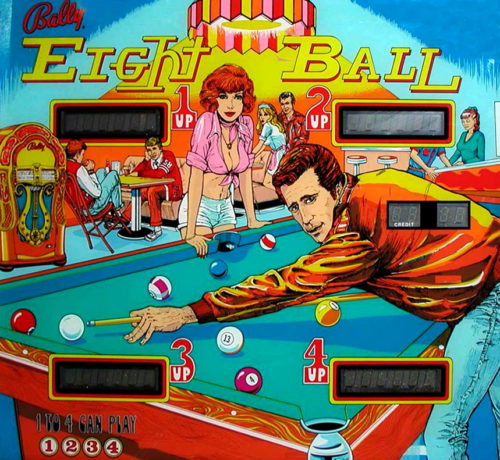 If you like “Happy Days” of TV fame, you’ll immediately notice “The Fonz” on the backglass. George Christian designed this machine and Paul Faris penned the artwork package. The machine was very popular in the early days of solid-state pinball. 20,230 games were made and most of them were played down to the wood subsurface under the artwork due to excessive play. The pool-themed game is set up so that players one and three’s goal is to score balls 1 to 7 and players two and four are after the 9 to 15 balls. Once completed, the eight-ball target lights. This machine has a built-in memory recall of each player’s efforts and the game continues on your next ball where you left off. Bonus awards are 3,000 points per ball lit with a holdover feature from your previous accomplishments. The right bonus lane advances the winnings by 2x, 3x, 5x , super bonus, extra balls and specials.
If you like “Happy Days” of TV fame, you’ll immediately notice “The Fonz” on the backglass. George Christian designed this machine and Paul Faris penned the artwork package. The machine was very popular in the early days of solid-state pinball. 20,230 games were made and most of them were played down to the wood subsurface under the artwork due to excessive play. The pool-themed game is set up so that players one and three’s goal is to score balls 1 to 7 and players two and four are after the 9 to 15 balls. Once completed, the eight-ball target lights. This machine has a built-in memory recall of each player’s efforts and the game continues on your next ball where you left off. Bonus awards are 3,000 points per ball lit with a holdover feature from your previous accomplishments. The right bonus lane advances the winnings by 2x, 3x, 5x , super bonus, extra balls and specials. -
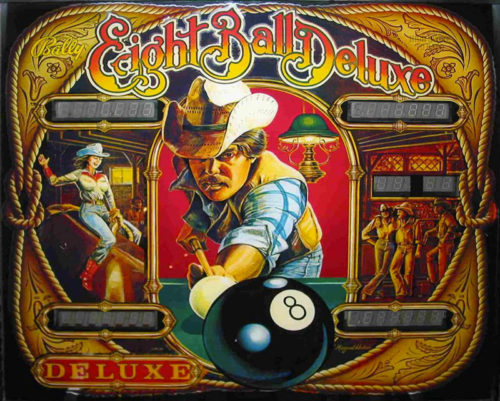 This game was very successful for the Bally company. It was initially released in 1981 as a full upright pinball with a production of 8,250 games. This version of the game in its third release had a run of 8,850 games. This cabinet was a unique design for Bally, as was used in a few other games like Pac-Man pinball. Designed by George Christian with art by Margaret Hudson, the pool-themed game is a classic. The basic object here is to hit all seven drop targets representing pool balls. The eight-ball drop target then pops up. Upon hitting it, “deluxe” lights up behind where the drop targets were. Making “deluxe” increases your bonus upon completion of the ball and advances the deluxe hold-over feature on the backglass. Hitting the in-line drop targets awards points and specials. The same is true if you shoot the left ramp to the top.
This game was very successful for the Bally company. It was initially released in 1981 as a full upright pinball with a production of 8,250 games. This version of the game in its third release had a run of 8,850 games. This cabinet was a unique design for Bally, as was used in a few other games like Pac-Man pinball. Designed by George Christian with art by Margaret Hudson, the pool-themed game is a classic. The basic object here is to hit all seven drop targets representing pool balls. The eight-ball drop target then pops up. Upon hitting it, “deluxe” lights up behind where the drop targets were. Making “deluxe” increases your bonus upon completion of the ball and advances the deluxe hold-over feature on the backglass. Hitting the in-line drop targets awards points and specials. The same is true if you shoot the left ramp to the top. -
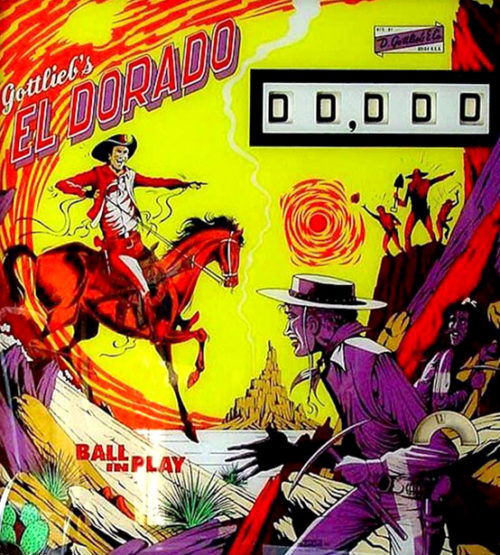 November marks the month of this game’s release. Design was one of Ed Krynski’s and art package was penned by Gordon Morison. This game had an add-a-ball version called Gold Strike as well as a re-released solid-state version. Gottlieb also duplicated this game design in Target Alpha (in the museum) and Canada Dry. 2,875 units were produced. If you like drop targets, this is your game. A battery of 10 drop targets are in the top of the playfield and a battery of 5 on the right mid-center. Four flippers are present for aiming at your foe. If you’re skillful enough to complete all the targets, a replay is awarded, 5,000 points are added, and a special lights up to score a replay if hit. If you drain your ball, the targets reset. An advancing light under the drop targets awards 5,000 points instead of the usual 500 points if you hit the drop target when it’s up and appropriately lit. Rollovers score 5,000 points when lit. Score awards replays also as well as matching.
November marks the month of this game’s release. Design was one of Ed Krynski’s and art package was penned by Gordon Morison. This game had an add-a-ball version called Gold Strike as well as a re-released solid-state version. Gottlieb also duplicated this game design in Target Alpha (in the museum) and Canada Dry. 2,875 units were produced. If you like drop targets, this is your game. A battery of 10 drop targets are in the top of the playfield and a battery of 5 on the right mid-center. Four flippers are present for aiming at your foe. If you’re skillful enough to complete all the targets, a replay is awarded, 5,000 points are added, and a special lights up to score a replay if hit. If you drain your ball, the targets reset. An advancing light under the drop targets awards 5,000 points instead of the usual 500 points if you hit the drop target when it’s up and appropriately lit. Rollovers score 5,000 points when lit. Score awards replays also as well as matching. -

-
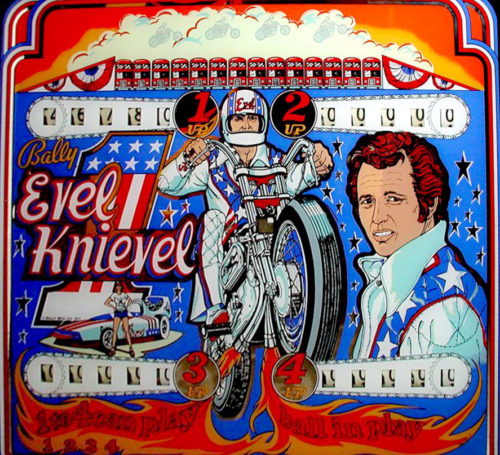 (Electromechanical Version) Bally released Evel Knievel in June of the year. Both electromechanical and solid-state versions of the game were fabricated. The reason two different platforms were made was due to the newness of the solid-state platform not being fully trusted or many arcade operators not being versed in the solid-state computerized machines. The “old faithful” mechanical versions used the same technology since the beginning of pinball that included relays, steppers, and score motors. This game was produced in mass quantity in the solid-state format with 14,000 pieces being fabricated. This game is one of only 155 made. This is probably one of the best examples of this rare run of machines. The play parallels the solid-state version, but an accumulated memory of targets hit isn’t stored in memory and awarded. This game just remembers your last hit of the last target. Enjoy!
(Electromechanical Version) Bally released Evel Knievel in June of the year. Both electromechanical and solid-state versions of the game were fabricated. The reason two different platforms were made was due to the newness of the solid-state platform not being fully trusted or many arcade operators not being versed in the solid-state computerized machines. The “old faithful” mechanical versions used the same technology since the beginning of pinball that included relays, steppers, and score motors. This game was produced in mass quantity in the solid-state format with 14,000 pieces being fabricated. This game is one of only 155 made. This is probably one of the best examples of this rare run of machines. The play parallels the solid-state version, but an accumulated memory of targets hit isn’t stored in memory and awarded. This game just remembers your last hit of the last target. Enjoy! -
Gottlieb released the game “Sinbad” in both solid-state and electromechanical formats in June of the year. Designed by Ed Krynski with art by Gordon Morison, there were 12,000 S.S. games and 950 E.M. games made. This machine is the rare two-player version of the game, of which 730 were made. Drop targets are the main theme of this game. Knocking down the single white drop target awards a 2x bonus and lights the white rollover. The three yellow drops were next. If hit, 3x bonus is awarded when the ball drains and the 5,000 rollover lights at the top of the playfield. The four purple drops were next. Making these would award 4x bonus and light the extra ball rollover. Finally, the five red drops; when hit would award 5x bonus (the maximum bonus that could register is 15,000 points times the bonus) as well as light the special rollover. Four flippers allowed for interesting play, also.